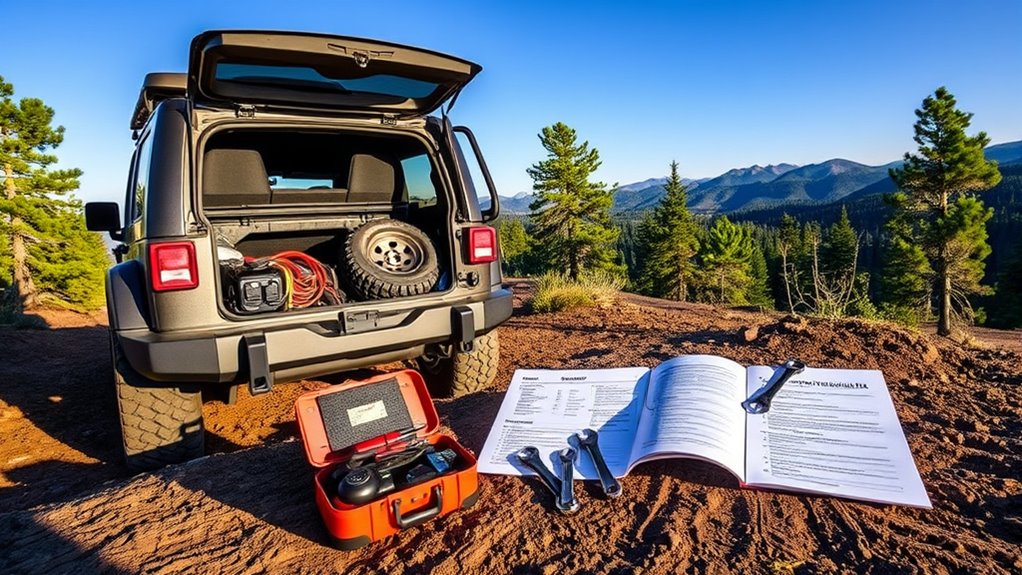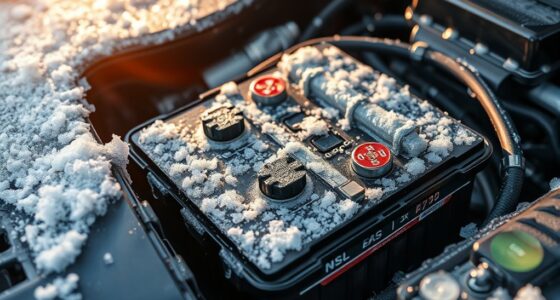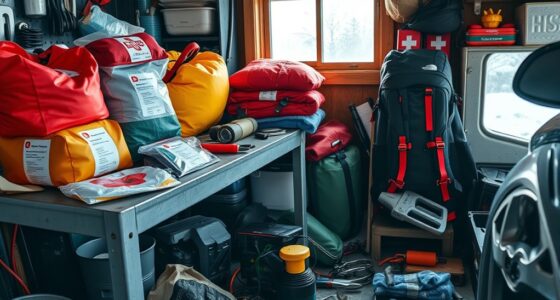Before heading out, make certain your 4×4 is trail-ready by inspecting tires for damage and proper pressure, and packing essential recovery gear like a tow strap and jack. Check fluid levels, belts, and batteries, and plan your route with updated maps and GPS. Practice recovery techniques, review safety procedures, and confirm your equipment works. Staying prepared will boost your confidence on tough terrain. Keep going to discover even more tips to maximize your adventure preparedness.
Key Takeaways
- Conduct a thorough vehicle inspection, including tires, fluid levels, belts, hoses, and battery condition.
- Ensure recovery gear like tow straps, shackles, and a high-lift jack are in good condition and accessible.
- Check tire pressure and inspect for damage or wear suited for off-road terrain.
- Review navigation tools, GPS, maps, and share trip plans with a trusted contact.
- Pack essential safety and emergency supplies, including a first aid kit, extra water, and communication devices.

Before hitting the trails, it’s essential to go through a thorough pre-trip off-road checklist to guarantee your vehicle is prepared for any challenges ahead. Off-roading tests your 4×4’s capabilities and your skills, so ensuring your vehicle is ready can make all the difference between a smooth adventure and a stressful situation. Start by inspecting your tires—check the tread depth and air pressure, making sure they’re suitable for the terrain you plan to tackle. Proper tire pressure not only improves traction but also helps prevent flats or blowouts, which are often the first issues you’ll want to avoid. Don’t forget to pack a tire repair kit, along with a portable air compressor, so you’re prepared in case of a puncture.
Next, review your vehicle’s recovery gear. It’s crucial to have a tow strap, a high-lift jack, shackles, and a winch if possible. Knowing how to use this equipment correctly can save you time and prevent damage to your vehicle during recovery situations. Keep your recovery gear easily accessible, and double-check that it’s in good condition. Remember, vehicle recovery isn’t just about gear—it’s about understanding how to use it safely and effectively. Practice or review recovery techniques before you set out, so you’re confident if the need arises.
Trail etiquette plays a vital role in off-road safety and preserving the environment. Respect other drivers by driving at a safe speed, yielding to oncoming traffic, and staying on designated trails. Always be courteous, especially around hikers, bikers, or wildlife, and leave no trace of your visit. Maintain a responsible attitude, and be mindful of local regulations and restrictions. When you encounter other vehicles, communicate clearly, whether through hand signals, radio, or lights, to coordinate vehicle recovery or passage. Respecting trail etiquette ensures a positive experience for everyone and helps keep off-road areas sustainable.
Finally, review your vehicle’s basic maintenance—check fluid levels, inspect belts and hoses, and ensure your battery is in good condition. Pack essential spare parts such as fuses, bulbs, and fluids. Bring along a comprehensive first aid kit, sufficient water, and emergency supplies. Confirm your GPS, maps, or trail apps are up-to-date, and share your trip plan with someone not on the trail. It’s also beneficial to familiarize yourself with off-road terrain features and their potential impact on vehicle handling. By thoroughly preparing your vehicle and understanding off-road etiquette, you set yourself up for a safer, more enjoyable adventure, ready to handle whatever the trail throws your way.
Frequently Asked Questions
How Often Should I Perform Maintenance on My 4×4 Before Off-Roading?
You should perform routine checks on your 4×4 before every off-road trip, ensuring everything is in top shape. Check tire pressure, fluid levels, and brakes regularly. An oil change is recommended every 3,000 to 5,000 miles or as specified in your vehicle’s manual. Doing these maintenance tasks frequently helps prevent breakdowns and keeps your vehicle reliable, so you’re ready for adventure without surprises.
What Specific Tools Are Recommended for Off-Road Vehicle Repairs?
You should carry essential tools for off-road repairs, including a basic repair kit and tire repair tools. These allow you to fix minor issues like punctures or loose parts on the trail. A good basic repair kit includes screwdrivers, pliers, and wrenches, while tire repair tools such as plugs and inflators help you quickly address flat tires. Being prepared with these tools keeps you safe and minimizes trail downtime.
How Can I Test My Vehicle’S Off-Road Capabilities Beforehand?
Did you know that nearly 60% of off-road vehicle failures are linked to suspension or tire traction issues? To test your vehicle’s off-road capabilities, start by inspecting your vehicle suspension for any damage or wear. Then, try controlled off-road maneuvers on similar terrain, paying attention to tire traction and handling. This helps identify potential problems and guarantees your vehicle’s prepared for the real adventure.
Are There Any Legal Requirements for Off-Road Vehicles in Remote Areas?
Before heading off-road, check for any legal requirements. You might need legal permits to access certain remote areas, especially protected parks or private land. Make sure your vehicle registration is current, as some regions require proof of ownership. Research local regulations beforehand to avoid fines or penalties. Staying compliant guarantees a smooth adventure and helps protect the environment, so always verify the rules for your specific destination.
What Should I Do if I Encounter a Mechanical Failure During My Trip?
Imagine you’re deep in the wilderness when your vehicle suddenly stalls—that’s when knowing what to do matters most. First, stay calm and assess the situation. Use your emergency repair skills for minor fixes, like tightening a loose belt, but don’t hesitate to call roadside assistance if needed. Staying prepared and cautious guarantees you handle the mechanical failure safely, keeping your adventure from turning into a predicament.
Conclusion
Before hitting the trail, remember that preparation is key—”a stitch in time saves nine.” Double-check your gear, fluids, and tires to guarantee a smooth adventure. Staying proactive keeps you safe and confident on off-road paths. When you’re well-prepared, you can enjoy the thrill of exploration without unnecessary worries. So, take your time with this checklist, and let your off-road journey be memorable for all the right reasons.









